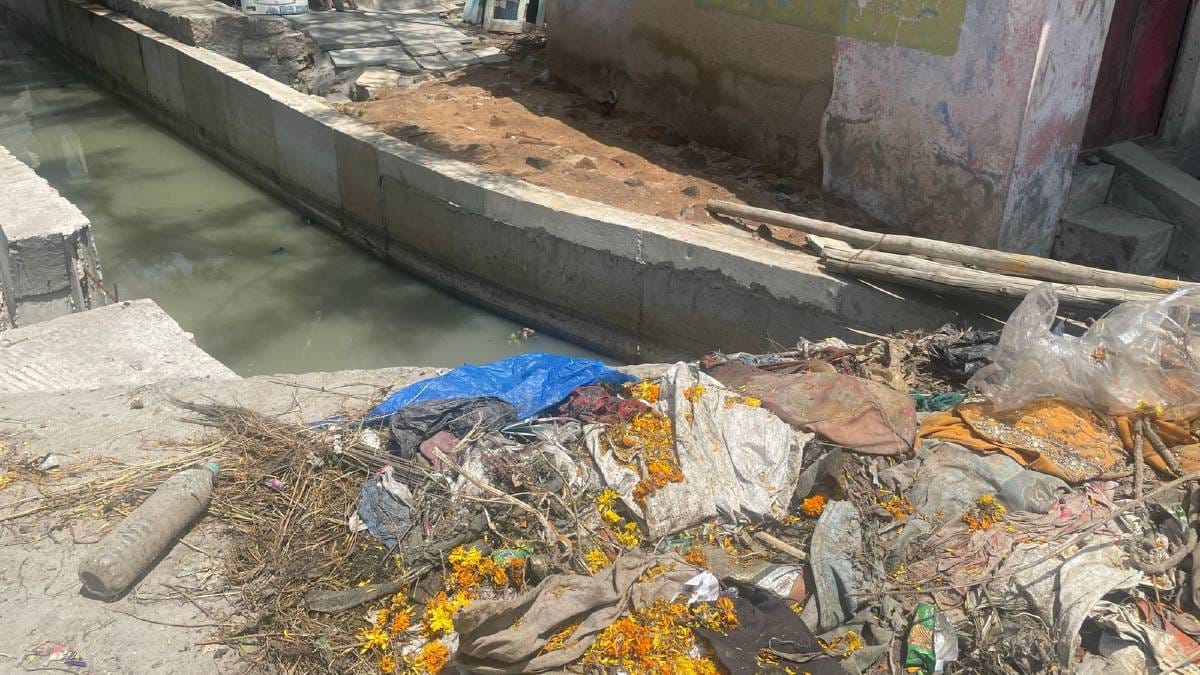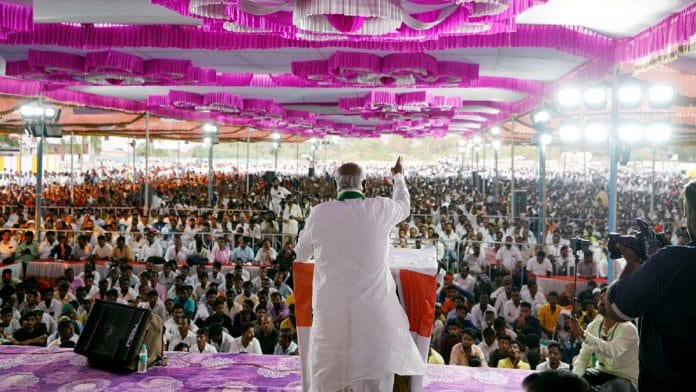Raichur/Yadgiri/Kalaburagi: At the Sundar Nagar slum in Karnataka’s Kalaburagi, human faeces lie on the streets, open drains stink up the neighbourhood and water supply comes once in five days, for an hour.
Residents of the Scheduled Caste (SC)-dominated slum have a lot to complain about, but lack of civic amenities doesn’t seem to be a swing factor when it comes to their voting preferences in the state’s 10 May assembly polls.
Muralidhar Upadhyay, a resident of Sundar Nagar, told ThePrint that the Congress has always ignored the SC-Left, but the BJP has undertaken development work in the areas dominated by the sub-caste, which is considered by experts as among the most oppressed historically. Sundar Nagar is primarily occupied by the SC-Left, which has traditionally been inclined towards the BJP.
“These roads that you see here have been widened by the BJP. For 40 years, the Congress and (party president) Mallikarjun Kharge didn’t pay attention to us. Now, before the elections, they are trying to woo us. Why should we vote for them?” Upadhyay asked.

This may come as a disappointment to the Congress, which was hoping to get political dividends from the appointment of Kharge, a Dalit from Kalaburagi, as the party’s national president last year.
Kharge is from the Holeya community (SC-Right), considered to have somewhat greater privileges compared to SC-Left). The opposition party is expecting the Kharge factor to cut ice with approximately 40 per cent of the Dalit population of the state who identify themselves as ‘SC-Left’, according to community experts.
The SC community in Karnataka is divided into four groups — ‘Right’, ‘Left’, ‘touchables’ and ‘others’.
Advocate S. Mareppa, a resident of Raichur and member of the SC-Left sub-category, claimed that the classification came from an 8th century incident in Tamil Nadu. “A temple run by goldsmiths (known as acharis) was attacked by Brahmins who wanted to capture it. At the time, to curry favour, some of the untouchables supported the Brahmins. Others supported the goldsmiths. Those who went with the Brahmins came to be known as the ‘Right’, while those who stood with the goldsmiths came to be known as the ‘Left’. Essentially, the ‘Left’ were the revolutionary sub-caste,” he said.
Dasanur Kusanna, an expert on caste issues from the Institute of Social and Economic Change (ISEC), on the other hand, told ThePrint that ‘Left’ and ‘Right’ were “occupational classifications”.
“The right hand side includes all communities related to land-based occupations while the left is non-land based and were in professions such as painting, leather work, scavenging and others, which became the reason why they were more oppressed and denied entry or access to most public spaces used by other caste Hindus,” Kusanna explained.
“Slowly, the rigid casteism and social barriers forced them to live in watertight compartments. So, they never inter-dined with any other,” he added.
According to James Manor, a political scientist and Emeritus Professor of Commonwealth Studies at the University of London, many caste groups do not identify themselves with either the ‘Left’ or ‘Right’ but may cling on to a sense of caste solidarity.
“In Karnataka, they are not as conflict-prone, not as bitter as the similar divisions between right and left-hand Dalits in Andhra Pradesh and Telangana. There the division is completely conflictual, while in Karnataka the division is less bitter,” Manor told ThePrint.
Also read: AIMIM, SDPI, KRPP, AAP — how small parties can queer pitch for BJP & Congress in Karnataka
Congress bid to consolidate SC-Right in Hyderabad-Karnataka region
In the Hyderabad-Karnataka or the Kalyana Karnataka region, considered one of the poorest in the country, the Congress is seeking to consolidate its vote-bank of SC-Right and ‘others’. It hasn’t given a single ticket to any SC-Left candidate in the region.
There are 41 assembly seats in the region, of which the Congress won 21 and the BJP 15 in the 2018 election.
A functionary of the Karnataka Congress told ThePrint that there are broadly two aspects to the Congress strategy as far as the SC community in the Hyderabad Karnataka region is concerned.
The first aspect is that of caste calculation, while the second deals with guarantees in the party manifesto.
“In the entire Kalyana Karnataka belt, we have not given even one seat (ticket) to the SC-Left. We have given more seats to the Bhovis and Banjaras (touchables). The number of seats for the SC-Right is the same as last time,” said the functionary.
“Usually, we give the ticket for Gulbarga Rural seat to the SC-Left community but this time it has been given to a Banjara. Another seat in Raichur for which the ticket is usually given to the SC-Left has been given to the Bhovi community. We are focussing on votes that will shift en masse,” added the functionary.
To woo the SC-Left, the Congress has promised to fulfil one of the group’s biggest demands in its manifesto — tabling of the Sadashiva Commission report in the first session of the Karnataka assembly if the party comes to power in this year’s election.
The Justice A.J. Sadashiva Commission had submitted a report in 2012 to the Sadananda Gowda-led Karnataka government, recommending internal reservation for communities among the SCs.
To offer representation to the SC-Left within the party, the Congress appointed B.N. Chandrappa, an SC-Left leader, as working president in the state in April.
Congress MP and Karnataka leader Naseer Hussain told ThePrint: “There should be social justice for all groups. How do we get them affirmative action? How do we see that every caste is represented in development and progress? For that we need to have separate strategies.”
The Congress’ strategy is not lost on the SC-Left.
“Out of 41 assembly seats in the Kalyana Karnataka region, (ticket for) not one has been given to the SC-Left by the Congress. More than 18 (of 36 reserved SC) seats Karnataka-wide have been given to the SC-Right. More than 10 seats have been given to the SC touchables. Tickets for only nine seats have been given to the SC-Left by the party,” advocate Mareppa, quoted earlier, pointed out.
He said that for the SC-Left community, there was no alternative to the BJP. “If we leave the BJP, where will we go?” he asked. “I don’t like the local BJP candidate here. But my vote for the BJP is because of the development PM Narendra Modi has promised.”
SC-Left and BJP’s reservation gambit
Shahid Patil is one of the very few residents of SC-Left-dominated Sundar Nagar who seem inclined towards the Congress.
“They (BJP-led government in Karnataka) have proposed to increase reservation to 6 per cent for the SC (Left) but within that, the Alemaris (a sub-caste) have been granted 2 per cent reservation. This means we are left with 4 per cent,” Patil said.
In October 2022, the Basavaraj Bommai-led Karnataka cabinet recommended reservation within reservation of 6 per cent for the SC-Left, 5.5 per cent for the SC-Right, 4.5 per cent for ‘touchables’ and 1 per cent for ‘others’.
But not many of Patil’s fellow SC-Left members are swayed by the reservation issue.
In Raichur’s Harijanawada, an SC-dominated locality, Govind, a Madiga (SC-Left), told ThePrint: “While the Congress has given us nine seats, the BJP has given us 11, just two more. Ultimately, I think our community will need to form its own party like the Bahujan Samaj Party (in Uttar Pradesh). It seems like no one is willing to fight for us,” he added.

There is a sense of despondency about the state of affairs even though they are clinging to hope that it may change.
Another resident of the locality, Narsimhran, a Madiga, said he would vote for the BJP, just like he did twice before.
“More than anyone else, we trust Modiji. The BJP has many leaders from our community so I believe they will work for us. I wish our problems of water and drainage will be solved. It’s been 40 years and this area doesn’t have water,” he pointed out.
His friend, Tayyappa, also a Madiga, added that the caste push by all parties was only an “election gimmick”.
“Before the elections, everyone thinks about the Madigas, but when they’re in power, no party helps us. For example, the housing board here hasn’t passed a loan in five years. There are no washrooms in our houses. The ones that do don’t have proper drainage. Everyone, including our women, has to go to the fields to relieve themselves. Irrespective of which party comes to power, I hope this changes,” he rued.
It’s this disillusioned section of the SC-Left that the Congress is pinning its hopes on.
(Edited by Nida Fatima Siddiqui)
Also read: Turncoats, some new faces, dynasty: Decoding BJP Karnataka list that has incensed many leaders






